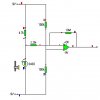mstechca
New Member
For the last while, I have been using LDR's as my light detectors.
I was thinking of switching to photodiodes because I only want to detect two levels of light: no light, and bright light.
Is a photodiode equivalent to a broken diode when no light falls on it?
and can someone give me some part numbers of photodiodes, becuase I may want to buy some shortly.
I was thinking of switching to photodiodes because I only want to detect two levels of light: no light, and bright light.
Is a photodiode equivalent to a broken diode when no light falls on it?
and can someone give me some part numbers of photodiodes, becuase I may want to buy some shortly.


